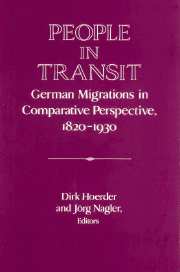Book contents
- Frontmatter
- Introduction
- PART I CONTINUITY AND COMPLEXITY: MIGRATIONS FROM EAST ELBIAN GERMANY AND GALICIAN POLAND
- Part II Internal German Migrations and In-Migrations
- PART III WOMEN'S MIGRATION: LABOR AND MARRIAGE MARKETS
- PART IV ACCULTURATION IN AND RETURN FROM THE UNITED STATES
- 14 Communicating the Old and the New: German Immigrant Women and Their Press in Comparative Perspective around 1900
- 15 Return Migration to an Urban Center: The Example of Bremen, 1850-1914
- 16 Migration, Ethnicity, and Working-Class Formation: Passaic, New Jersey, 1889-1926
- 17 Changing Gender Roles and Emigration: The Example of German Jewish Women and Their Emigration to the United States, 1933-1945
- 18 Migration Past and Present - The German Experience
- 19 Research on the German Migrations, 1820s to 1930s: A Report on the State of German Scholarship
- Index
14 - Communicating the Old and the New: German Immigrant Women and Their Press in Comparative Perspective around 1900
Published online by Cambridge University Press: 05 January 2013
- Frontmatter
- Introduction
- PART I CONTINUITY AND COMPLEXITY: MIGRATIONS FROM EAST ELBIAN GERMANY AND GALICIAN POLAND
- Part II Internal German Migrations and In-Migrations
- PART III WOMEN'S MIGRATION: LABOR AND MARRIAGE MARKETS
- PART IV ACCULTURATION IN AND RETURN FROM THE UNITED STATES
- 14 Communicating the Old and the New: German Immigrant Women and Their Press in Comparative Perspective around 1900
- 15 Return Migration to an Urban Center: The Example of Bremen, 1850-1914
- 16 Migration, Ethnicity, and Working-Class Formation: Passaic, New Jersey, 1889-1926
- 17 Changing Gender Roles and Emigration: The Example of German Jewish Women and Their Emigration to the United States, 1933-1945
- 18 Migration Past and Present - The German Experience
- 19 Research on the German Migrations, 1820s to 1930s: A Report on the State of German Scholarship
- Index
Summary
That women were an important part of the German American reading public is suggested by the female-oriented materials that began to proliferate in the late nineteenth century. This segment of the immigrant press included women's magazines as well as women's pages. During the course of the nineteenth century a combination of demographic and social factors had worked to expand the reading public. Mirroring the development of the English-speaking press's historical changes over time, the German American press adopted its products to court the woman consumer.
Yet it is only now that researchers of German immigration have begun to analyze the role of gender. Little tribute has been paid to the role of the ethnic press specifically designed for women and only some isolated issues have been addressed. This state of historical research on the German American women's press reflects a phenomenon common to all ethnic groups in the United States. While considerable progress has been made in the study of the immigrant press during the past ten years, even the newer studies fail to acknowledge the crucial role of the ethnic women's press. By considering it mainly to be a by-product of the male-dominated ethnic press, they not only lose sight of the immense commercial success and longevity of several ethnic women's magazines, but they also miss a chance to follow up on issues offered by the women's press that defy easy categorization and go beyond the set of questions traditionally asked.
- Type
- Chapter
- Information
- People in TransitGerman Migrations in Comparative Perspective, 1820–1930, pp. 313 - 328Publisher: Cambridge University PressPrint publication year: 1995

